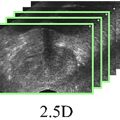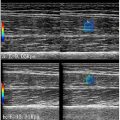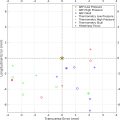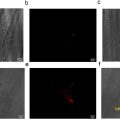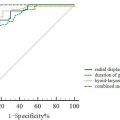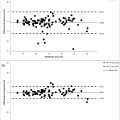Abstract
Objective
This study aimed to investigate the low-intensity pulsed ultrasound (LIPUS) therapeutic effects on knee joint dysfunction after immobilization following trauma and to identify the optimum LIPUS intensity and duration.
Methods
A knee post-traumatic joint contracture (PTJC) model was established in male Wistar rats divided into three groups: front irradiation (n = 4), medial irradiation (n = 3), and sham (n = 3). LIPUS irradiation was performed for 20 min/day (30 mW/cm 2 [spatial average temporal average] SATA, 1 MHz, duty cycle of 20%, 5 times/week, for 2 weeks). PTJC model rats were also divided into LIPUS and sham groups with LIPUS performed at different intensities (30 or 120 mW/cm 2 SATA) and durations (5 or 20 min). The range of motion (ROM) of the knee joint with skin and muscles (knee ROM) and without (knee joint intrinsic ROM) and the length of the posterior joint capsule and the intra-articular adhesion of the knee joint were evaluated.
Results
Knee ROM and knee joint intrinsic ROM were significantly larger in the front LIPUS group ( p < 0.01). The length of the posterior capsule was significantly higher in the LIPUS groups ( p < 0.01), but no significant differences between the LIPUS groups were observed. The intra-articular adhesion length was significantly lower in the 120 mW/cm 2 –20 min group than those in the 30 mW/cm 2 –5 min group ( p < 0.01). The effects on LIPUS intensity and duration to intra-articular adhesion were not synergistic but additive.
Conclusion
LIPUS therapy may be a rehabilitation approach for preventing knee joint dysfunction after trauma or surgical invasion.
Introduction
Post-traumatic joint contracture (PTJC) causes structural and biomechanical alterations, restricts joint motion, and elicits chronic pain. These symptoms reduce the patient’s quality of life [ , ]. Contractures after trauma include postfracture and connective tissue injury [ , ], and large joints such as the knee, shoulder, and elbow are at particular risk [ ]. For severe conditions, full recovery cannot be expected even after sufficient rehabilitation or surgical intervention [ , ], and thus PTJC is an important target of postoperative management. A post-traumatic model in rat knee joints has been previously established through intra-articular injury followed by immobilization of the animals [ ]. The authors clarified that shortening the posterior capsule length and developing adhesion between tissues caused by PTJC are likely to restrict joint motion. In immobility-induced contractures, the tissues surrounding the joint contribute to the irreversible limitation in range of motion (ROM) via capsular shortening or arthrofibrosis. A prolonged rehabilitation program using continuous passive motion for PTJC is effective in improving the ROM. However, an efficient rehabilitation procedure during the acute phase requiring immobilization has not been proposed. Therefore, it is necessary to develop novel strategies to prevent joint dysfunctions.
In low-intensity pulsed ultrasound (LIPUS), pulsed waves of a noninvasive and safe nature are emitted that exhibit thermal activity. The effects of LIPUS have been explored, making it a widely utilized method in clinical settings for treating fractures, soft tissue injuries, and other conditions [ ]. LIPUS inhibits joint capsule fibrosis in a joint contracture model [ , ]. However, the effects of LIPUS on PTJC with intra-articular adhesion remain unclear. Furthermore, the optimal direction and parameters for LIPUS irradiation to enhance joint functionality are unknown. Unlike our previous studies [ , ], which primarily investigated PTJC modeling or muscle atrophy following immobilization, this study specifically examines the therapeutic efficacy of LIPUS for PTJC with a focus on optimizing intensity and duration for maximum benefit. Therefore, this study aimed to investigate the LIPUS therapeutic effects and identify the optimum LIPUS intensity and duration for PTJC to prevent knee joint dysfunction.
Materials and methods
Animals
A total of 40 male Wistar rats (weight, 268 ± 21 g; age, 12 weeks) were used in this study. The study design is shown in Figure 1 . Rats with a knee joint contracture were obtained as a trauma model as described later. Ten rats were randomly divided into three groups, sham (n = 3), medial irradiation (med LIPUS group) (n = 3), and front irradiation (front LIPUS group) (n = 4), and were treated for 14 days (30 mW/cm 2 , 20 min). The other 30 rats were used to identify the optimal parameters of LIPUS irradiation at the frontal side. They were randomly divided into five groups, 0 mW/cm 2 (sham), n = 6; 30 mW/cm 2 , 5 min, n = 6; 30 mW/cm 2 , 20 min, n = 6; 120 mW/cm 2 , 5 min, n = 6; and 120 mW/cm 2 , 20 min, n = 6, and were also treated for 14 days. Rats were housed in plastic cages under controlled conditions with a 12-h light/dark cycle and access to standard rodent chow and water and libitum. This study was approved by the Animal Research Committee of Kyoto University (approval number: MedKyo19028) and was conducted following the regulations.
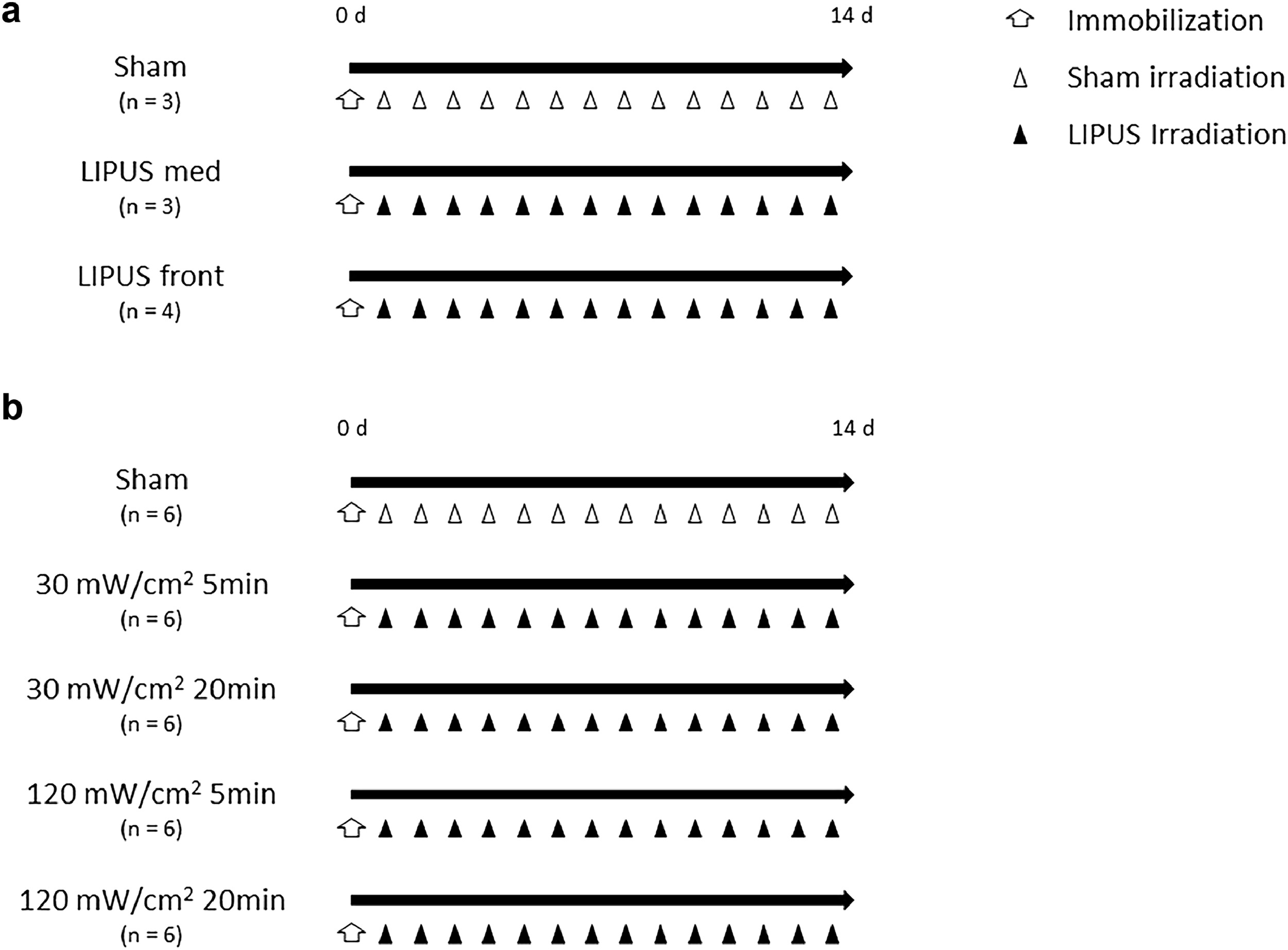
Surgery
All surgical procedures were performed under 2% isoflurane inhalation anesthesia. We obtained a rat knee PTJC model as previously described [ ]. Briefly, Kirschner wires (K-wires) of 0.8 mm diameter (1-210-150-21, Iso Medical Systems, Tokyo, Japan) were inserted in the right femur and tibia of rats. After K-wire insertion, an incision was made in the medial joint capsule (1 cm-long) using a surgical blade, and the patella was manually dislocated laterally from the femoral pulley groove for 5 min. The joint capsule and skin were then closed using a 4-0 nylon suture (S15G04N-45, Bear Medic, Tokyo, Japan). The right knee was then immobilized using resin in a deep flexural posture. Bleeding was managed equally in each group, with sterilization gauze utilized to eliminate it during the operation to the fullest extent possible. After the surgical procedures, the rats were returned to their respective cages and closely observed for any abnormal symptoms throughout the intervention period. All subjects completed the experimental protocol without any fatalities or significant postoperative issues.
Ultrasound protocol
In this study, an ultrasonic treatment apparatus (UST-770; Ito, LTD, Japan) was employed. The transducer had an effective radiation area of 0.9 mm 2 , with a beam nonuniformity of 2.9. The treatment protocol consisted of ultrasound parameters set at a 1-MHz acoustic frequency, 1-kHz repetition frequency, spatial average temporal average intensity of 30 or 120 mW/cm 2 , and a 20% duty cycle administered for 5 or 20 min/day. We chose to investigate an intensity of 30 mW/cm², which is commonly used in studies of joint contracture models and has been widely reported to be effective in modulating tissue responses. To explore the potential benefits of higher intensities, we included 120 mW/cm² in our experimental design, which allowed us to evaluate whether an increased intensity could yield greater therapeutic effects or introduce adverse outcomes. Regarding the duration of the ultrasound application, a standard intervention time of 20 minutes was selected based on its frequent use in studies and clinical practice. Additionally, a shorter duration of 5 minutes was tested to assess whether a reduced treatment time could still provide therapeutic benefits, potentially enhancing the feasibility and practicality of LIPUS application in clinical settings. Considering that our animal model experienced trauma on the anteromedial side, we applied coupling gel to the skin overlying the front or medial aspect of the immobilized knee joint. This was the area where the ultrasound transducer was placed to ensure optimal treatment targeting the regions most affected by the injury. All rats were anesthetized with 2% isoflurane and subjected to daily ultrasound or sham stimulation (0 mW/cm 2 ) from the first postoperative day throughout the intervention period.
Joint angle measurement
Angle analysis was conducted on all animals under 2% isoflurane anesthesia. Following the removal of the K-wire, the ROM of the right knee joint was assessed with the skin and muscles intact (knee ROM). Subsequently, after the animals were euthanized under deep isoflurane anesthesia, the ROM was measured again without the skin and muscle (knee joint intrinsic ROM). The measurements were taken with the hip joint approximately flexed at 90° in the neutral spine position while applying a 0.49 N force to the leg using a tension gauge (DS2 series, Imada, Toyohashi, Japan) as previously described [ ]. The angle between the femur and tibia was determined using a digital ROM measuring device (Easy Angle; Ito, LTD, Japan).
Tissue preparation
The right knees were dissected after measuring the knee joint intrinsic ROM. Subsequently, the knee joints were fixed in 4% paraformaldehyde overnight and decalcified in 10% ethylenediaminetetraacetic acid. The specimens were then embedded in paraffin. Sagittal sections, 6-µm thick, were obtained at intervals of 100 µm from the center of the knee joint to the medial site using a microtome (RM2125 RTS, Leica, Nussloch, Germany). These sections were stained with hematoxylin and eosin (H&E) following standard procedures. Image analysis was performed using ImageJ software (National Institutes of Health, Bethesda, MD, USA).
Measurement of lengths in the posterior capsule and adhesions
The length of the posterior capsule and intra-articular adhesions were assessed from H&E-stained images using ImageJ software (National Institutes of Health, Bethesda, MD, USA). To assess the posterior capsule length, it was divided into superior and inferior posterior segments, consistent with previous studies [ ]. The measurements were obtained from a single section of the same region of each specimen. Subsequently, the individual lengths of these segments were combined to obtain the total length of the posterior capsule for each sample. The average length of each group was determined by averaging the measurements across all the specimens within each group. Intra-articular adhesions were assessed following established methods [ ]. Adhesion was characterized as an abnormal band of tissue forming between the two surfaces of the patella-femoral joint in the knee joint. Tissue continuity, which is typically absent under normal conditions, was confirmed through a detailed examination of magnified H&E-stained images. Adhesion lengths were evaluated at all medial condylar sites in the sagittal section, with measurements taken at 200-μm intervals. The mean adhesion length was calculated by averaging the data from three consecutive sections where the total adhesion length reached its maximum value.
Statistical analysis
JMP 17 Pro software (SAS Institute, Cary, NC, USA) was used for statistical analyses. The normality of the data distribution was verified using the Shapiro–Wilk test, confirming that the data followed a normal distribution. One-way analysis of variance (ANOVA) followed by the Tukey–Kramer test was applied to compare each group. The interaction of irradiation intensity and duration was analyzed using two-way ANOVA. Data are expressed as mean ± standard deviation. p -value < 0.05 was considered statistically significant.
Results
Knee joint angle changes
Measurements of the knee joint angle are depicted in Figure 2 . Knee ROM was significantly greater in the front LIPUS group compared to both the sham and med LIPUS groups ( Fig. 2 a). Furthermore, knee ROM was significantly elevated in the 120 mW/cm 2 –5 min and 120 mW/cm 2 –20 min groups compared to the sham and 30 mW/cm 2 –5 min groups ( Fig. 2 b). Knee ROM increased with higher intensity, although no significant changes were observed with irradiation duration ( Table 1 ). There was no observed interaction effect between irradiation intensity and duration ( Table 1 ). Knee joint intrinsic ROM was markedly higher in the front LIPUS and med LIPUS groups compared to the sham group ( Fig. 2 a). No additive effect was observed at each irradiation intensity and duration ( Fig. 2 b, Table 1 ).


